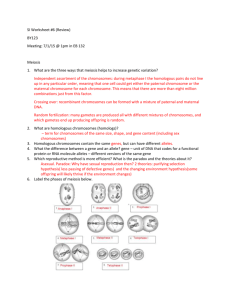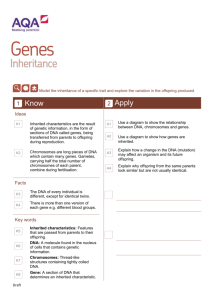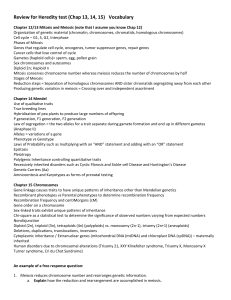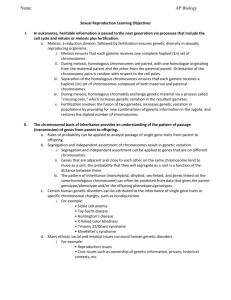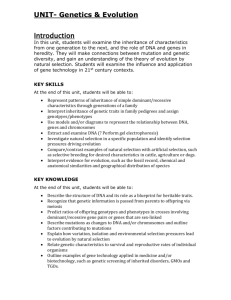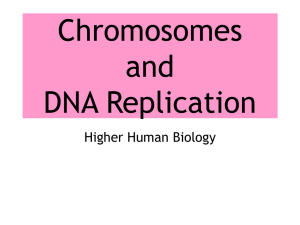Unit 5: Heredity - Westford Academy Ap Bio
advertisement
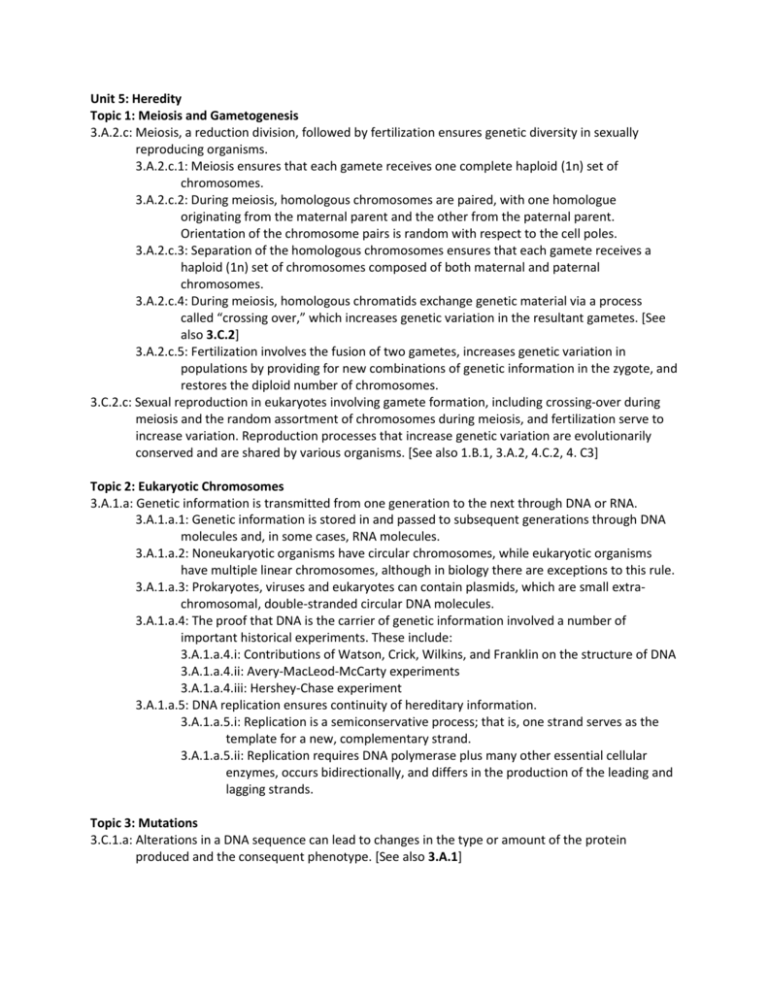
Unit 5: Heredity Topic 1: Meiosis and Gametogenesis 3.A.2.c: Meiosis, a reduction division, followed by fertilization ensures genetic diversity in sexually reproducing organisms. 3.A.2.c.1: Meiosis ensures that each gamete receives one complete haploid (1n) set of chromosomes. 3.A.2.c.2: During meiosis, homologous chromosomes are paired, with one homologue originating from the maternal parent and the other from the paternal parent. Orientation of the chromosome pairs is random with respect to the cell poles. 3.A.2.c.3: Separation of the homologous chromosomes ensures that each gamete receives a haploid (1n) set of chromosomes composed of both maternal and paternal chromosomes. 3.A.2.c.4: During meiosis, homologous chromatids exchange genetic material via a process called “crossing over,” which increases genetic variation in the resultant gametes. [See also 3.C.2] 3.A.2.c.5: Fertilization involves the fusion of two gametes, increases genetic variation in populations by providing for new combinations of genetic information in the zygote, and restores the diploid number of chromosomes. 3.C.2.c: Sexual reproduction in eukaryotes involving gamete formation, including crossing-over during meiosis and the random assortment of chromosomes during meiosis, and fertilization serve to increase variation. Reproduction processes that increase genetic variation are evolutionarily conserved and are shared by various organisms. [See also 1.B.1, 3.A.2, 4.C.2, 4. C3] Topic 2: Eukaryotic Chromosomes 3.A.1.a: Genetic information is transmitted from one generation to the next through DNA or RNA. 3.A.1.a.1: Genetic information is stored in and passed to subsequent generations through DNA molecules and, in some cases, RNA molecules. 3.A.1.a.2: Noneukaryotic organisms have circular chromosomes, while eukaryotic organisms have multiple linear chromosomes, although in biology there are exceptions to this rule. 3.A.1.a.3: Prokaryotes, viruses and eukaryotes can contain plasmids, which are small extrachromosomal, double-stranded circular DNA molecules. 3.A.1.a.4: The proof that DNA is the carrier of genetic information involved a number of important historical experiments. These include: 3.A.1.a.4.i: Contributions of Watson, Crick, Wilkins, and Franklin on the structure of DNA 3.A.1.a.4.ii: Avery-MacLeod-McCarty experiments 3.A.1.a.4.iii: Hershey-Chase experiment 3.A.1.a.5: DNA replication ensures continuity of hereditary information. 3.A.1.a.5.i: Replication is a semiconservative process; that is, one strand serves as the template for a new, complementary strand. 3.A.1.a.5.ii: Replication requires DNA polymerase plus many other essential cellular enzymes, occurs bidirectionally, and differs in the production of the leading and lagging strands. Topic 3: Mutations 3.C.1.a: Alterations in a DNA sequence can lead to changes in the type or amount of the protein produced and the consequent phenotype. [See also 3.A.1] 3.C.1.a.1: DNA mutations can be positive, negative or neutral based on the effect or the lack of effect they have on the resulting nucleic acid or protein and the phenotypes that are conferred by the protein. 3.C.1.b: Errors in DNA replication or DNA repair mechanisms, and external factors, including radiation and reactive chemicals, can cause random changes, e.g., mutations in the DNA. 3.C.1.b.1: Whether or not a mutation is detrimental, beneficial or neutral depends on the environmental context. Mutations are the primary source of genetic variation. 3.C.1.c: Errors in mitosis or meiosis can result in changes in phenotype. 3.C.1.c.1: Changes in chromosome number often result in new phenotypes, including sterility caused by triploidy and increased vigor of other polyploids. [See also 3.A.2] 3.C.1.c.2: Changes in chromosome number often result in human disorders with developmental limitations, including Trisomy 21 (Down syndrome) and XO (Turner syndrome). [See also 3.A.2, 3.A.3] 3.C.2.a: The imperfect nature of DNA replication and repair increases variation. Topic 4: Inheritance Patterns 3.A.1.d: Phenotypes are determined through protein activities. 3.A.3.a: Rules of probability can be applied to analyze passage of single gene traits from parent to offspring. 3.A.3.b: Segregation and independent assortment of chromosomes result in genetic variation. 3.A.3.b.1: Segregation and independent assortment can be applied to genes that are on different chromosomes. 3.A.3.b.2: Genes that are adjacent and close to each other on the same chromosome tend to move as a unit; the probability that they will segregate as a unit is a function of the distance between them. 3.A.3.b.3: The pattern of inheritance (monohybrid, dihybrid, sex-linked, and genes linked on the same homologous chromosome) can often be predicted from data that gives the parent genotype/phenotype and/or the offspring phenotypes/genotypes. 3.A.3.c: Certain human genetic disorders can be attributed to the inheritance of single gene traits or specific chromosomal changes, such as nondisjunction. 3.A.3.d: Many ethical, social and medical issues surround human genetic disorders. 3.A.4.a: Many traits are the product of multiple genes and/or physiological processes. 3.A.4.a.1: Patterns of inheritance of many traits do not follow ratios predicted by Mendel’s laws and can be identified by quantitative analysis, where observed phenotypic ratios statistically differ from the predicted ratios. 3.A.4.b: Some traits are determined by genes on sex chromosomes. 3.A.4.c: Some traits result from nonnuclear inheritance. 3.A.4.c.1: Chloroplasts and mitochondria are randomly assorted to gametes and daughter cells; thus, traits determined by chloroplast and mitochondrial DNA do not follow simple Mendelian rules. 3.A.4.c.2: In animals, mitochondrial DNA is transmitted by the egg and not by sperm; as such, mitochondrial-determined traits are maternally inherited. 4.C.1.a: Variations within molecular classes provide cells and organisms with a wider range of functions. [See also 2.B.1, 3.A.1, 4.A.1, 4.A.2] 4.C.1.b: Multiple copies of alleles or genes (gene duplication) may provide new phenotypes. [See also 3.A.4, 3.C.1] 4.C.1.b.1: A heterozygote may be a more advantageous genotype than a homozygote under particular conditions, since with two different alleles, the organism has two forms of proteins that may provide functional resilience in response to environmental stresses. 4.C.1.b.2. Gene duplication creates a situation in which one copy of the gene maintains its original function, while the duplicate may evolve a new function.


